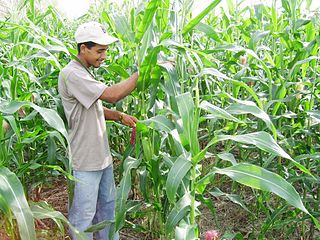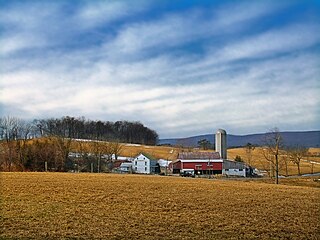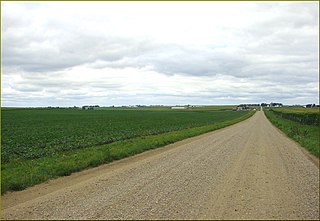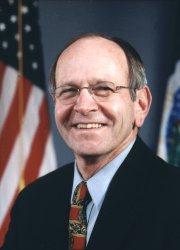
Leland is a city in Washington County, Mississippi, United States. It is located within the Mississippi Delta, on the banks of Deer Creek. The population was 4,481 at the 2010 census. It was once a railway town and had long been a center of cotton culture, which is still an important commodity crop in the rural area. It was once considered the second-largest city in Washington County in 1920 due to its rapid growth of residents, businesses, and schools.

Agriculture is a major industry in the United States, which is a net exporter of food. As of the 2017 census of agriculture, there were 2.04 million farms, covering an area of 900 million acres (1,400,000 sq mi), an average of 441 acres per farm.

The Corn Belt is a region of the Midwestern United States that, since the 1850s, has dominated corn production in the United States. In the United States, corn is the common word for maize. More generally, the concept of the Corn Belt connotes the area of the Midwest dominated by farming and agriculture.

Edward Thomas Schafer is an American businessman and politician who was the 30th governor of North Dakota from 1992 to 2000. Schafer also served as the 29th United States Secretary of Agriculture from 2008 to 2009, appointed by President George W. Bush. From January to July 2016 he served as interim president of the University of North Dakota.
American Farmland Trust is a nonprofit organization in the United States with a mission to protect farmland, promote environmentally sound farming practices, and keep farmers on the land. AFT is staffed by farmers, policy experts, researchers and scientists, and governed by a board of directors. Its headquarters are in Washington, D.C., and it has regional offices throughout the country. AFT also runs the Farmland Information Center, an online collection of information on farmland and ranchland protection and stewardship established as a public-private partnership with the USDA Natural Resources Conservation Service.

The Farm Security and Rural Investment Act of 2002, also known as the 2002 Farm Bill, includes ten titles, addressing a great variety of issues related to agriculture, ecology, energy, trade, and nutrition. This act has been superseded by the 2007 U.S. Farm Bill.
The Under Secretary for Research, Education, and Economics is a high-ranking official within the United States Department of Agriculture that provides leadership and oversight for the Agricultural Research Service, National Institute of Food and Agriculture, Economic Research Service, National Agricultural Library, National Agricultural Statistics Service.

Intensive crop farming is a modern industrialized form of crop farming. Intensive crop farming's methods include innovation in agricultural machinery, farming methods, genetic engineering technology, techniques for achieving economies of scale in production, the creation of new markets for consumption, patent protection of genetic information, and global trade. These methods are widespread in developed nations.

Charles Franklin "Chuck" Conner is a former United States Deputy Secretary of Agriculture.

William Howard Northey is an American politician who served as the Under Secretary for Farm Production and Conservation in the United States Department of Agriculture from 2018 to 2021. A member of the Republican Party, he previously served as the Secretary of Agriculture of Iowa, first elected on November 7, 2006 and sworn in on January 2, 2007. In that position he led he led the Iowa Department of Agriculture and Land Stewardship.

Throughout its history, agriculture in Paraguay has been the mainstay of the economy. This trend has continued today and in the late 1980s the agricultural sector generally accounted for 48 percent of the nation's employment, 23 percent of GDP, and 98 percent of export earnings. The sector comprised a strong food and cash crop base, a large livestock subsector including cattle ranching and beef production, and a vibrant timber industry.

Agriculture in Panama is an important sector of the Panamanian economy. Major agricultural products include bananas, cocoa beans, coffee, coconuts, timber, beef, chicken, shrimp, corn, potatoes, rice, soybeans, and sugar cane.

Conservation programs for the Mississippi River watershed have been designed to protect and preserve it by implementing practices that decrease the harmful effects of development on habitats and to overlook monitoring that helps future planning and management. A main focus is nutrient pollution from agricultural runoff of the nation's soybean, corn and food animal production, and problems relating to sediment and toxins. Conservation programs work with local farmers and producers to decrease excess nutrients because they cause major water quality problems along with hypoxia and loss of habitat. Organizations such as the Mississippi River/Gulf of Mexico Watershed Nutrient Task Force and USDA programs such as the Upper Mississippi River Forestry Partnership and the Mississippi River Basin Healthy Watersheds Initiative contribute to conserving what is left of the Mississippi River watershed.

Agriculture is a major industry in the U.S. commonwealth of Pennsylvania. As of the most recent United States Census of Agriculture conducted in 2017, there were 53,157 farms in Pennsylvania, covering an area of 7,278,668 acres with an average size of 137 acres per farm. In 2016, Pennsylvania ranked first in the United States in Agaricus mushroom production, fourth in apple production, fourth in Christmas tree production, fifth in dairy sales, fifth in grape production, and seventh in winemaking.

The production of corn plays a major role in the economy of the United States. The US is the largest corn producer in the world, with 96,000,000 acres (39,000,000 ha) of land reserved for corn production. Corn growth is dominated by west/north central Iowa and east central Illinois. Approximately 13% of its annual yield is exported.

William Brent Jackson is an American politician and businessman serving as a Republican member of the North Carolina General Assembly, representing the state's tenth Senate district, which includes Duplin, Johnston, and Sampson counties.
Kentucky is an agricultural producer in the United States. Value of agricultural products was $5 billion in 2012, of which slightly less than half was crops. Crops grown in the state include corn, soybeans, hay, wheat and tobacco. Historically, hemp has been a cash crop in the state. Finished agricultural products produced in the state include Kentucky bourbon and Kentucky wine.

Agriculture is a significant sector in Wisconsin's economy, producing nearly $104 billion in revenue annually. The significance of the state's agricultural production is exemplified by the depiction of a Holstein cow, an ear of corn, and a wheel of cheese on Wisconsin's state quarter design. In 2017 there were 64,800 farms in the state, operating across 14.3 million acres of land.

The 2018 farm bill or Agriculture Improvement Act of 2018 is an enacted United States farm bill that reauthorized $867 billion for many expenditures approved in the prior farm bill. The bill was passed by the Senate and House on December 11 and 12, 2018, respectively. On December 20, 2018, it was signed into law by President Donald Trump.

Farmers' suicides in the United States refers to the national occurrences of farmers taking their own lives, largely since the 1980s, partly due to their falling into debt, but as a larger mental health crisis among U.S. agriculture workers. In the Midwest alone, over 1,500 farmers have taken their own lives since the 1980s. It mirrors a crisis happening globally: in Australia, a farmer dies by suicide every four days; in the United Kingdom, one farmer a week takes their own life; and in France it is one every two days. In India more than 270,000 farmers have died by suicide since 1995.
















